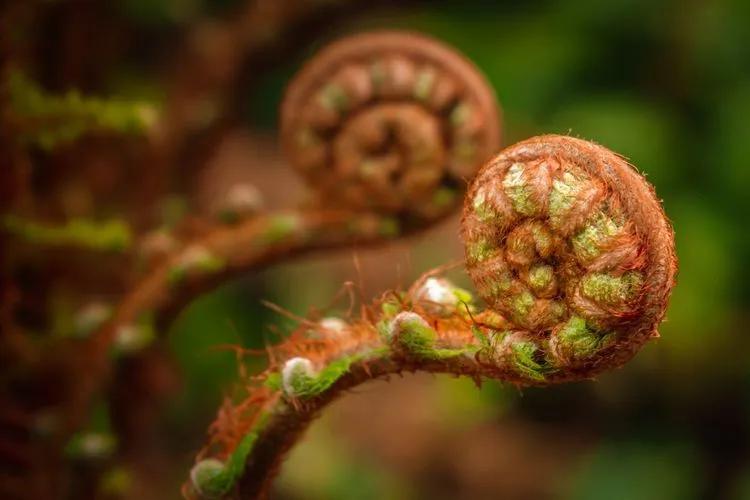Ferns are a group of vascular plants that reproduce via spores. In Slavic folklore, there is a legend that the one who finds a blooming fern will be happy and lucky forever. In fact, ferns don’t bloom at all, but these cuties still can bring joy and happiness to your home as houseplants.
What is unique about ferns?
 These plants have lived on the planet since the Carboniferous period, so they are pretty ancient! During these prehistoric times, ferns were much more giant. Mostly they were growing gigantic trees. Now their sizes vary from 0, 39 - 0, 47 inches to 30ft or even 80 ft.
These plants have lived on the planet since the Carboniferous period, so they are pretty ancient! During these prehistoric times, ferns were much more giant. Mostly they were growing gigantic trees. Now their sizes vary from 0, 39 - 0, 47 inches to 30ft or even 80 ft.
Also, they are notable for their way of reproducing - they reproduce via spores, so they have no flowers and seeds in the classical meaning. Ferns have two detached living stages, and there are no other plants like that in the world. These stages are called sporophyte plant and gametophyte. Spores grow into a gametophyte, a tiny plant. This reproductive mechanism is a key to classifying them, and this is the main characteristic that distinguishes them from other plants.
How can they be helpful?
There are a lot of fern species that are used for consumption and medical purposes. For example, ostrich fern (Matteuccia struthiopteris) was eaten by North American indigenous nations and is still cultivated for this purpose. In eastern Asian cuisines, an osmunda and Pteridium (eagle fern) are often used; however, there are debates about their carcinogenic qualities. Different types of ferns can be used for curing stomach aches and parasitic invasions, such as royal ferns, rock ferns, mountain wood ferns, bracken ferns, etc. Many of them are also helpful with blood problems. Ferns’ medical qualities can be used in treating rheumatism, lung problems, and even gynecological issues.
How to keep them indoors?
 As you have already noticed, ferns aren’t only pretty but functional in different ways. But their practical qualities aren’t the key reasons to own these plants. Of course, the aesthetic purpose is the main cause why people decide to keep them as green pets. So here’s the list of what these plants do and don’t like.
As you have already noticed, ferns aren’t only pretty but functional in different ways. But their practical qualities aren’t the key reasons to own these plants. Of course, the aesthetic purpose is the main cause why people decide to keep them as green pets. So here’s the list of what these plants do and don’t like.
Temperature
Various species of ferns prefer different temperatures. In the wild, you can find some species in the Arctic and Antarctic regions. But mostly, they are into warm weather. In domestic conditions, the average room temperature from 65 to 70˚F (18-21˚C) is the best. Don’t worry if it’s slightly hotter in your apartment. In this case, just water the plant slightly more often. But when the temperature drops lower than 50˚F (10˚C), the ferns won’t be pleased. Remember, indoors; these plants love stability, so don’t keep them too close to hot objects or next to windows or doors in the winter.
Light
When it comes to sunlight, you need a perfect balance. First of all, ferns need a lot of light, but they must be indirect. So you should place your plant on north or east-facing windows. These plants can tolerate low-light conditions for some time, but constant lack of it can cause changes in the foliage color — leaves will become yellowish. The plant’s development will slow down. But there are some species for which lack of light won’t be a problem. For example, maidenhair, rabbit’s foot, lemon button, and many others will handle low light perfectly! Just give them enough moisture.
Watering and humidity
Ferns adore water, so be sure that their soil is moist enough but not constantly wet. For watering, choose the water at room temperature. Another important thing - don’t let the soil dry completely between waterings. However, some species will tolerate dry soil (rabbit’s feet, Japanese holy ferns, etc.).
Also, ferns thrive in high humidity, so don’t hesitate to mist your green pets. If you notice that the air in your home is too dry, place the pot in a shallow container filled with pebbles and water (but make sure that the pot itself does not touch the water). This will increase the humidity near your green pet.
Soil
 The best soil for ferns is the one with a high amount of nutrients and good drainage. Some soil mixes that include high peat content, perlite, etc., are excellent because they ensure regular aeration. At the same time, such potting mix ingredients keep it moist between the waterings. When you choose the soil, you should keep in mind the type of your fern. For most species, slightly acidic and neutral soils are a perfect choice. But if you are an owner of maidenhair fern, you need more alkaline soil.
The best soil for ferns is the one with a high amount of nutrients and good drainage. Some soil mixes that include high peat content, perlite, etc., are excellent because they ensure regular aeration. At the same time, such potting mix ingredients keep it moist between the waterings. When you choose the soil, you should keep in mind the type of your fern. For most species, slightly acidic and neutral soils are a perfect choice. But if you are an owner of maidenhair fern, you need more alkaline soil.
Ferns have different qualities, gastronomical, medical, and, of course, aesthetic. And the most important thing is that it's so easy to take care of them! We encourage you to adopt this lush cutie soon if you don’t have any ferns in your home oasis yet.
